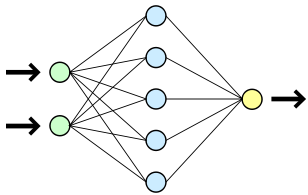The principle of a neural network is to schematically reproduce the human brain and its way of associating items so as to automatise the process into a machine: it is commonly called artificial intelligence. Like our brain, neural networks start with a learning phase, associating inputs (image, sound, text…) to specific categories as reference (like recognition of a word from the picture of text).

Machine learning thanks to neural networks
“Artificial neural networks are inspired by biological neural networks. They are often assimilated to artificial intelligence.”
Once this study is done, when new data occurs, neural network will link it to a certain category according to what it learned: it is classification.
Neural network works thanks to statistic analysis whereas other learning systems make decisions following a set of rules (algorithmic logic).
How does it work and what for?
The concept of a neural network is to create statistic reasoning. According to what has been learned in the past, and thanks to a learning “base”, it will make decisions in relation to its inputs. The classification choice is made considering the probability of a similarity with a known class. This is also called “experiential learning”, neural network intervenesas a statistic help to make the decision.
Step-by-step principle:
- input data (black arrow on the left)
- data analysis with weighted criteria (circles and connections)
- classification choice with a degree of probability as output (black arrow on the right)
Neural networks exist in many sectors of daily life: classification of species, pattern recognition (cheque, postcards…), market estimation…

How to automatically sort of different kinds of fish species thanks to artificial vision?
This algorithm was designed for a company that designs and sells specialised devices for sorting and calibrating, used in the agri-food sector.
To create new equipment capable of sorting fishes according to their species and size, this company’s wish is to use automatised classification techniques through learning and shape recognition, and to know the efficiency of this kind of technique.
Acsystème designed, created, on Matlab, and evaluated a module design to learn and recognise fish species before implementing it into the machine.

In a first step, an assessment protocol of classification systems was developed and simulated for our particular problem. The evaluation measures the different sorts of errors (incorrect reject, incorrect detections) and their statistical validity. Investigating the recognition unit consisted in developing and choosing relevant image descriptors for species based discrimination, and using several classifiers designed with neural networks. A morphologic analysis of fishes made it possible to free the process from knowing their position in front of camera. Simulations help to assess different classification strategies from images acquired by the machine without the cost and the limits of a full-scale test (installation of equipment at Lorient auction market, reception of fresh fishes when boats unload their catch).
Acsystème designed a neural network learning software to set up strategies according to an image database of which the purpose is to compare strategies to each other on the basis of costs related to a compromise between conceivable errors (incorrect reject against incorrect detection).
Finally, Acsystème implemented the simulation code into the machine’s software environment in order to dynamically load learned neural networks for new species recognition.
Current limits
The neural network represents the computer programs’ artificial intelligence but numerous elements limit their capacities:
- The more complex the problem is, the more important the size of the database is, increasing the cost in terms of time and money.
- Descriptor definition needs an expert’s analysis. With the same database, different definitions of descriptors may generate neural networks with very different performance levels.
